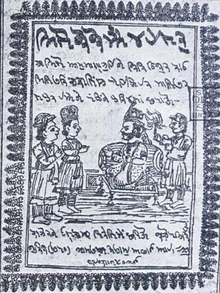Khudabadi script
| Khudabadi 𑊻𑋩𑋣𑋏𑋠𑋔𑋠𑋏𑋢 | ||
|---|---|---|
 The word "Sindhi" written in the Khudabadi script | ||
| Script type | ||
Time period | c. 16th century–present | |
| Direction | Left-to-right Unicode range | U+112B0–U+112FF |
[a] The Semitic origin of the Brahmic scripts is not universally agreed upon. | ||
| Brahmic scripts |
|---|
| The Brahmi script and its descendants |
Khudabadi (देवदेन/ Devden) was a script used to write the

History


The Khudabadi script has roots in the
The Khudabadi script was created by the
After
Sir
- The Sindhi Language in Arabic Script to be used for government office use, on the ground that Muslim names could not be written in Devanagari.
- The Education Department should give the instructions to the schools in the script of Sindhi which can meet the circumstance and prejudices of the Mohammadan and Hindu. It is thought necessary to have Arabic Sindhi Schools for Muslims where the Arabic Script will be employed for teaching and to have Hindu Sindhi Schools for Hindus where the Khudabadi Script will be employed for teaching.
In the year 1868, the Bombay Presidency assigned Narayan Jagannath Vaidya (Deputy Educational Inspector of Sindh) to replace the Abjad script used for Sindhi with the Khudabadi script. The script was decreed a standard script modified with ten vowels by the Bombay Presidency.[8] The Khudabadi script of Sindhi language did not make further progress. Traders continued to maintain their records in this script till the independence of Pakistan in 1947.
The present script predominantly used in Sindh as well as in many states in India and else, where migrants Hindu Sindhi have settled, is Arabic in Naskh styles having 52 letters. However, in some circles in India, Khudabadi and Devanagari is used for writing Sindhi. The Government of India recognizes both scripts.[7]
Alphabet
Khudabadi is an
Modern Khudabadi has 37 consonants, 10 vowels, 9 vowel signs written as
| 𑊰 | 𑊱 | 𑊲 | 𑊳 | 𑊴 | 𑊵 | 𑊶 | 𑊷 | 𑊸 | 𑊹 |
|---|---|---|---|---|---|---|---|---|---|
| ə | a | ɪ | i | ʊ | uː | e | ɛ | o | ɔ |
| 𑊺 | 𑊻 | 𑊼 | 𑊽 | 𑊾 | 𑊿 | ||||
|---|---|---|---|---|---|---|---|---|---|
| k | kʰ | ɡ | ɠ | ɡʱ | ŋ | ||||
| 𑋀 | 𑋁 | 𑋂 | 𑋃 | 𑋄 | 𑋅 | ||||
| c | cʰ | ɟ | ʄ | ɟʱ | ɲ | ||||
| 𑋆 | 𑋇 | 𑋈 | 𑋉 | 𑋋 | 𑋊 | 𑋌 | |||
| ʈ | ʈʰ | ɖ | ɗ | ɖʱ | ɽ | ɳ | |||
| 𑋍 | 𑋎 | 𑋏 | 𑋐 | 𑋑 | |||||
| t | tʰ | d | dʱ | n | |||||
| 𑋒 | 𑋓 | 𑋓𑋩 | 𑋔 | 𑋕 | 𑋖 | 𑋗 | |||
| p | pʰ | f | b | ɓ | bʱ | m | |||
| 𑋘 | 𑋙 | 𑋚 | 𑋛 | ||||||
| j | r | l | ʋ | ||||||
| 𑋜 | 𑋝 | 𑋞 | |||||||
| ʃ | s | h | |||||||
Numerals
| Khudabadi numerals | 𑋰 | 𑋱 | 𑋲 | 𑋳 | 𑋴 | 𑋵 | 𑋶 | 𑋷 | 𑋸 | 𑋹 |
|---|---|---|---|---|---|---|---|---|---|---|
| Hindu-Arabic numerals | 0 | 1 | 2 | 3 | 4 | 5 | 6 | 7 | 8 | 9 |
Unicode
Khudabadi script was added to the Unicode Standard in June 2014 with the release of version 7.0.
Khudabadi is being used as the unified encoding for all of the Sindhi scripts except for
The Unicode block for Khudabadi, called Khudawadi, is U+112B0–U+112FF:
| Khudawadi[1][2] Official Unicode Consortium code chart (PDF) | ||||||||||||||||
| 0 | 1 | 2 | 3 | 4 | 5 | 6 | 7 | 8 | 9 | A | B | C | D | E | F | |
| U+112Bx | 𑊰 | 𑊱 | 𑊲 | 𑊳 | 𑊴 | 𑊵 | 𑊶 | 𑊷 | 𑊸 | 𑊹 | 𑊺 | 𑊻 | 𑊼 | 𑊽 | 𑊾 | 𑊿 |
| U+112Cx | 𑋀 | 𑋁 | 𑋂 | 𑋃 | 𑋄 | 𑋅 | 𑋆 | 𑋇 | 𑋈 | 𑋉 | 𑋊 | 𑋋 | 𑋌 | 𑋍 | 𑋎 | 𑋏 |
| U+112Dx | 𑋐 | 𑋑 | 𑋒 | 𑋓 | 𑋔 | 𑋕 | 𑋖 | 𑋗 | 𑋘 | 𑋙 | 𑋚 | 𑋛 | 𑋜 | 𑋝 | 𑋞 | 𑋟 |
| U+112Ex | 𑋠 | 𑋡 | 𑋢 | 𑋣 | 𑋤 | 𑋥 | 𑋦 | 𑋧 | 𑋨 | 𑋩 | 𑋪 | |||||
| U+112Fx | 𑋰 | 𑋱 | 𑋲 | 𑋳 | 𑋴 | 𑋵 | 𑋶 | 𑋷 | 𑋸 | 𑋹 | ||||||
| Notes | ||||||||||||||||
See also
References
- ^ "Landa script".
- OCLC 1604024.
- ISBN 978-1-135-79711-9.
- ISBN 978-0415772945, pages 72-74
- ^ Purswani, Gangaram Shamdas (2009). Incredible Origin and History of Khudabadi Sindhi Swarankar Community. Anil Computer & Consultations.
- ISBN 9788170222354.
- ^ a b "Sindhi Language: Script". Archived from the original on 19 April 2012. Retrieved 15 May 2012.
- ^ "Omniglot: Sindhi alphabets, pronunciation and language". Retrieved 15 May 2012.
